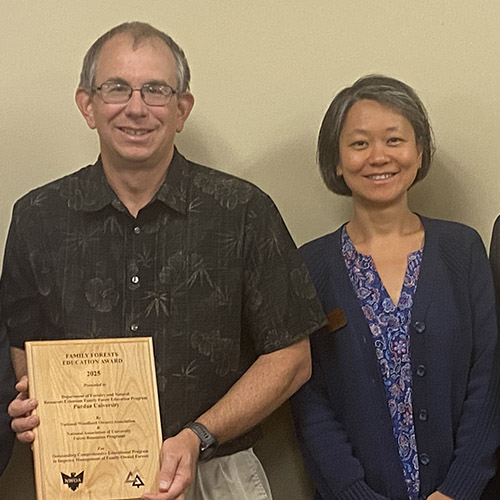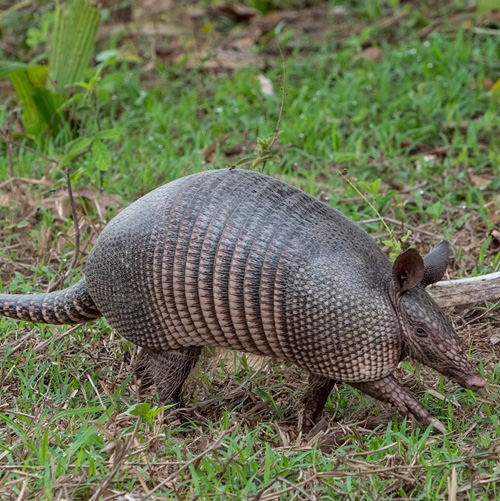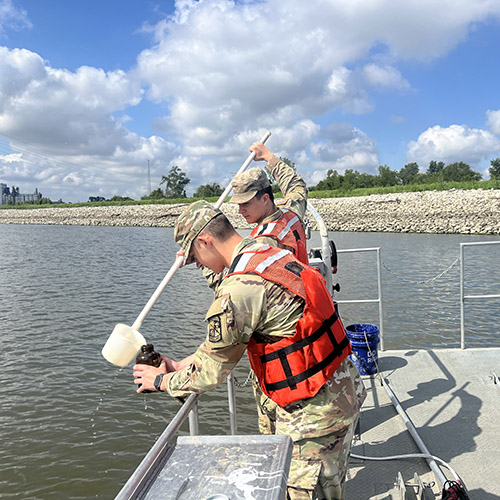Glenn Juday Named FNR Lifetime Achievement Award Honoree
Glenn Juday was born and raised in Indiana. He grew up first in the urban sprawl of Indianapolis where his father was a hog buyer, then the small town of Frankfort, where the family lived near cornfields and a small remnant of forest. In 1960, the family moved to the west side of Frankfort, onto a plot of land with 18 acres of forest near Wildcat Creek. That marked a seminal moment for Glenn, who was always interested in nature but didn't have the opportunity to encounter it often.
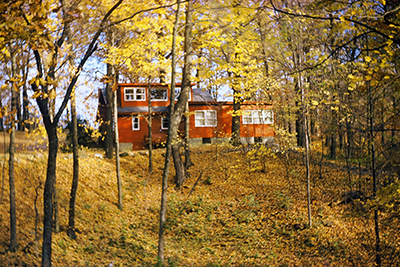 "Moving opened a door to a world that I knew existed, but had never had that sense that I would be immersed in it," Juday said. "It was like going up to the door of a gigantic mansion, knocking and having the door swing open and everything is all there for the taking. It was so immersive and all inclusive, the sights, the sounds, the smells, the experiences. I could just play all day and there was always something new to see. As a kid, you're always exploring the world and learning new things, but there was something amplified about it when we moved. I took to it immediately and that was it."
"Moving opened a door to a world that I knew existed, but had never had that sense that I would be immersed in it," Juday said. "It was like going up to the door of a gigantic mansion, knocking and having the door swing open and everything is all there for the taking. It was so immersive and all inclusive, the sights, the sounds, the smells, the experiences. I could just play all day and there was always something new to see. As a kid, you're always exploring the world and learning new things, but there was something amplified about it when we moved. I took to it immediately and that was it."
While exploring the woods near his home, Juday often carried his copy of the Fifty Trees of Indiana, a book which was utilized by 4-H groups throughout the state. Juday noticed the difference in the trees he saw and learned that they also had names, and individual characteristics and roles to play. He also expanded his horizons through family trips to state parks or vacations in the Hiawatha National Forest in northern Michigan.
After working with his father on his hog and cattle farms, including rounding up the cattle, freeze branding, inoculations and just general farm chores, like cleaning the hog barns, Juday was clear that he had different plans for his life.
"As far as a career, everything was looking up from cleaning hog barns, but I was looking for the opportunity to be involved with nature and apply the intellectual skills I was attaining. I was running a hog farm, while there were people who were hired to run a national forest. I didn't really know all of the different sub areas of forestry, but the first course I took at Purdue clued me in, and when forest ecology came up, it clicked."
Although Juday was intrigued by forest ecology, each course he took opened his eyes to more possibilities. It soon became clear that his career would have to be multifaceted to match his interests in conservation, environmental policy, forest and wildlife.
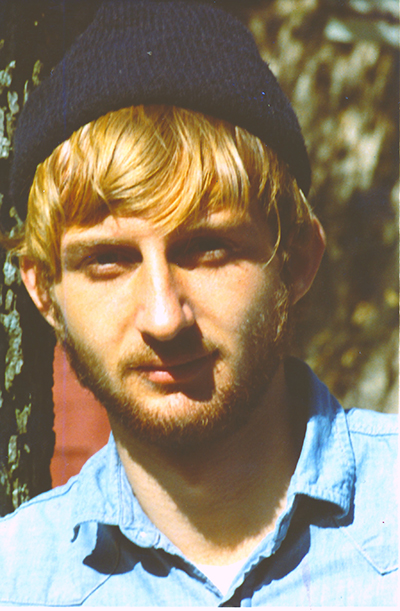 "There were several classes that clued me in to the idea that whatever I was going to do, it was not going to be a specialization," Juday recalled. "Durward Allan's wildlife ecology class, Claire Merit's silviculture class, Walt Beineke, George Parker and more, I found it all interesting. The integrative approach of conservation and the natural areas movement seemed to be just the thing for me. I thought 'wow, you mean somebody would pay me to do all of these things.' I used to hesitate to say that, because I thought if they knew how much fun I was having, they might not offer me any money."
"There were several classes that clued me in to the idea that whatever I was going to do, it was not going to be a specialization," Juday recalled. "Durward Allan's wildlife ecology class, Claire Merit's silviculture class, Walt Beineke, George Parker and more, I found it all interesting. The integrative approach of conservation and the natural areas movement seemed to be just the thing for me. I thought 'wow, you mean somebody would pay me to do all of these things.' I used to hesitate to say that, because I thought if they knew how much fun I was having, they might not offer me any money."
In addition to his classwork and summer camp experience, Juday's career path was shaped by volunteer and real-world work experiences.
Juday's first professional job came between his freshman and sophomore year when he hired on as a timber management assistant for the Siskiyou National Forest in Southwest Oregon.
"Southwest Oregon is a center of diversity for tree species and the Siskiyou National Forest was solidly in the middle of that," Juday said. "Most places out West, there are just a few tree species, but in Southwest Oregon, it is sugar pine, western white pine and cypresses out the wazoo along with Port Orford cedars and a lot of strange and wonderful things. The Oregon experience struck me in that it was an environment where forest management was a big deal in the whole society, unlike where I grew up where farming and industry were."
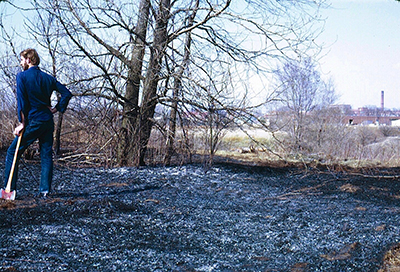 In 1970, Juday helped organize Purdue's Earth Day activities. In 1971, he worked to turn an unexcavated corner of the Purdue gravel pit near the power plant into a prairie area, inspired by ecologist Alton Lindsey, who is widely credited for the creation of nature preserves in Indiana.
In 1970, Juday helped organize Purdue's Earth Day activities. In 1971, he worked to turn an unexcavated corner of the Purdue gravel pit near the power plant into a prairie area, inspired by ecologist Alton Lindsey, who is widely credited for the creation of nature preserves in Indiana.
"We were at a real turning point and we needed to do better in our treatment of the environment," Juday said. "We wanted to do something that was an input into the social dialogue and that would change the social policy agenda, but we didn't need to be bomb throwers. I was never oriented that way. There was a sense that if we organized and communicated with one another, we could make waves, but we wanted to do something logical, reasonable, implementable, and tangible, in a constructive way."
Between his junior and senior year, Juday worked for the Indianapolis Parks Department, which had just taken over responsibility for the parkways, or strips of land along the stream courses in the city, which were in rough shape.
"It really sensitized me to the issue of invasive species, because everyone's backyard was full of exotic, introduced species of trees and shrubs, and birds would eat those and perch on the trees in parkways and drop the seeds. It was a mess," Juday remembered. "I just put my education to work to figure out what we could do with a bunch of sprouts. I did a careful marking of the trees and we picked the one stem that was likely to become dominant and had the chance to grow into a mature tree and everything else was to be cut. We only marked those that were native species. Now, whenever I go back to Indianapolis, I drive along the parkways where we did that project and look at the forest. Fifty years later, some of them are starting to look pretty good. I always had this sense of forestry as an engaged profession that is enmeshed in society. We do it for social and human values, including helping pristine nature survive."
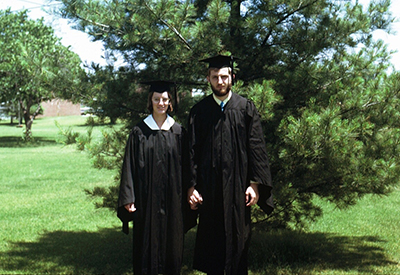 Juday earned the Purdue Agricultural Alumni Association's Senior Achievement Award in 1972, before graduating with his degree in forest management. The award was given to one graduating senior who excelled above all others in scholastic work, extra-curricular activities and general attitude. After completing his degree, he contributed to the plan for an Indiana Natural and Scenic Rivers system, which was introduced in 1974.
Juday earned the Purdue Agricultural Alumni Association's Senior Achievement Award in 1972, before graduating with his degree in forest management. The award was given to one graduating senior who excelled above all others in scholastic work, extra-curricular activities and general attitude. After completing his degree, he contributed to the plan for an Indiana Natural and Scenic Rivers system, which was introduced in 1974.
Juday decided to continue his education and work toward a PhD in plant ecology at Oregon State University. Initially, Juday hoped to study the species rich part of the Siskiyou Mountains, but the project never came together. His major advisor offered Juday a McIntyre Stennis funded project on the Oregon coast range.
"Immediately when I got there and started driving around, I saw that it was a burned-up place that had been logged over and had very little old growth left, but I said, ok, I'll do it and it all started clicking," Juday recalled. "The perspective of conservation urgency, of there's only a few remnants left, got transferred right away to the coast range. With all of the big science names working in the remaining stands of old growth in the Cascades, I became the de facto Mr. Coast Range. That led to the wilderness areas, the Drift Creek, Rock Creek and Commons Creek Wilderness bills in Congress and all of that. That's how it happened."
While working along the coast, Juday noticed that Oregon did not have a legislatively established natural areas program, and that the state would readily take an important area for biodiversity and put a campground on it. He also found that the common school lands in Oregon, or lands designated by Congress for each state to use to earn revenue to support the common schools, were most rangeland or inaccessible forest lands, where trees were being removed with the exclusive goal of profit.
"I knew that if we were going to break through this mentality, it would have to be at a high enough executive level for someone to tell the parks director to put some natural areas on the parks, state forests, common school lands and state wildlife areas," Juday said. "I spent a good part of the fall of 1972 and spring of 1973 lobbying, knocking on state legislators' doors explaining the bill and just made a pest of myself. We were cashing in on the afterglow of Environmental Earth Day and the environmental movement gaining momentum. I learned a lot about bureaucracies, executive decision-making processes in natural resources, about the diversity of Oregon and its ecosystems and it was a fantastic experience."
Juday finished his PhD in 1976 and presented his dissertation on "The location, composition and structure of old growth forest on the Oregon Coast Range," but the push for legislated natural areas was far from over, so he took a post-doctoral fellowship in environmental affairs and picked up the legislative battle full 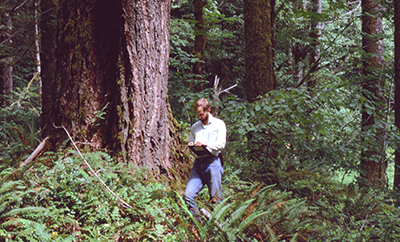 time as the executive chair of the Oregon Natural Area Preserve Advisory Committee. Eventually, the initial areas that Juday and his team proposed were established as state nature preserves in Oregon in 1978.
time as the executive chair of the Oregon Natural Area Preserve Advisory Committee. Eventually, the initial areas that Juday and his team proposed were established as state nature preserves in Oregon in 1978.
Juday also was able to bring the value of old growth forests and specifically the commercially valuable Douglas fir forests to Governor Tom McCall. Shortly after, Juday participated in a critical workshop and one publication produced from it was a Forest Service Pacific Northwest Research Station general technical report about the value of old growth forests. The report includes a simple four-class scheme to be used by land managers as a reminder of which old growth forest features were favored or depended on by local species: large live old trees, large standing dead trees, large dead trees on the ground or large logs in streams.
While the legislative efforts continued in Oregon, Juday hired on as a research scientist for the USDA Forest Service at the Institute of Northern Forestry in Fairbanks, Alaska, in 1977, while also working as the Alaska Ecological Reserves Coordinator.
"Because I served as an ex-officio member of the federal research natural areas committee, the Forest Service's Pacific Northwest Research Station, which included Oregon, Washington and Alaska, was acutely aware of me," Juday said. "The Alaska lands issue was coming to a head after the passage of the Alaska Native Claims Settlement Act and the greenlight of the oil pipeline. They needed somebody to apply new insights and approaches of systematic ecological survey and biodiversity concerns and come up with a cooperative plan, regardless of the land ownership and make it work. That's what I was brought there to do. I was just out of grad school and it was the pinnacle of my interests in natural resources, happening in the biggest and last piece of North America going through that process, and I was there doing it."
Juday was a research scientist at the Pacific Northwest Research Station and the Ecological Preserves Coordinator for 10 years, during which he put together a network of 40 research natural areas. From 1985 to 1989, he also served as president of the Natural Areas Association, which served his fellow land managers and scientists in the U.S. and Canada.
In 1987, Juday transitioned to a teaching and research role as a professor of forest ecology at the University of Alaska Fairbanks, a position he served in for 30 years. He taught courses in natural resource decision making, forest management, conservation, and tree ring analysis, among others before developing a conservation biology class, one of the earliest with that title in the United States.
In his career, his research topics included forest management, climate change, forest development and regeneration following fire and forest harvest, tree ring studies, and biodiversity and wilderness management. His experience with old growth forests and interest in the long-term processes that had 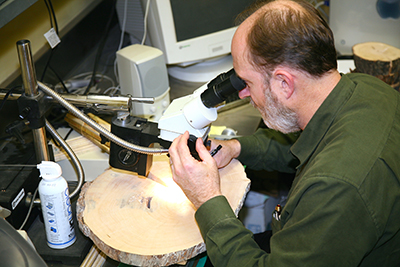 caused the 1983 Rosie Creek Fire on the Bonanza Creek Experimental Forest, which he was directing a project on at the time, led Juday to look into tree ring studies.
caused the 1983 Rosie Creek Fire on the Bonanza Creek Experimental Forest, which he was directing a project on at the time, led Juday to look into tree ring studies.
"We can unlock the past with a detailed examination of the tree growth histories," Juday explained. "Ninety percent of the work in tree rings was bioclimatic. The tree will tell us what the climate was back 100, 200 or 300 years ago. I wasn't interested in that per se, but I gave it a try. I was looking forward to a nice quiet academic pursuit, a little respite from the hyper-controversial issues I had been plunged into previously. I found some really interesting stories about what tree rings were telling us about climate. I got into climate change figuring it was an academic field that wasn't going to have all the controversial stuff attached to it, and then it all blew up into the climate change issue. I rode the leading edge of that for quite some time, and of course, it continues to evolve."
Juday began investigating climate change variability in 1980, beginning more than 40 years of research on the topic. In 1982, Juday helped organize and acted as the chair of one of the first scientific symposia assessing potential climate change effects in the far north. In 2000, he published "Reduced growth of Alaskan white spruce in the twentieth century from temperature-induced drought stress" in Nature, a paper which has become instrumental for climate change studies based on information stored in trees and tree 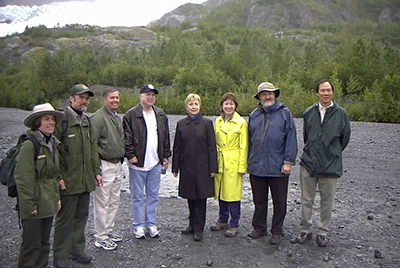 rings. He has briefed or advised four U.S. presidents or presidential candidates as well as many other political figures on policy related to climate change and biodiversity. His climate change work has been featured in media products from USA Today and National Geographic to the BBC and more. He is a contributor to the U.S. national climate change assessment and a lead author for the chapter on forests in the international Arctic Climate Impact Assessment.
rings. He has briefed or advised four U.S. presidents or presidential candidates as well as many other political figures on policy related to climate change and biodiversity. His climate change work has been featured in media products from USA Today and National Geographic to the BBC and more. He is a contributor to the U.S. national climate change assessment and a lead author for the chapter on forests in the international Arctic Climate Impact Assessment.
"Somebody had to take a broader perspective and offer a reasonable distillation of what we knew that science had told us and what it could tell us about climate change. The threads that ran continuously through my science advising were a commitment to the truth; the integrity of the scientific method; the diversity of interests that came into play at any given time or given situation; and the creative thinking we could bring to the issues."
Juday's advisory roles were not solely tied to climate change, he also acted as a consulting advisor to the Exxon Valdez Oil Spill Trustee Council and helped produce its Guiding Principles. He also serves on the University Advisory Board for the Center for Legislative Energy and Environmental Research (CLEER), supporting the work of The Energy Council.
Beyond the impact of his research and science advising efforts, Juday has influenced the next generation of natural resource professionals. His graduate students have gone on to their own successes. Martin Wilmking, one of Juday's PhD students, received the Sofja Kovaleveskaja Award for outstanding young researchers, one of the most highly-endowed German scientific prizes from the Alexander von Humboldt Foundation. He also was appointed to the Young Academy of Science in Germany and later served as its president.
"Dr. Juday is a world-renowned forest ecologist, and his path-making research on climate change based on dendrochronology records has been published in Nature and other top scientific journals," Dr. Jingjing Liang said. "While I was a junior faculty member at the University of Alaska, Glenn was my first faculty mentor. He once invited two journalists from Le Figaro, who traveled from France to Alaska to interview him, and me on a trip to a boreal forest near Fairbanks, AK. He showed us how he studied climate change in the region using tree ring data. It was an amazing trip, and a perfect demonstration of how Dr. Juday made science easy for the public to understand."
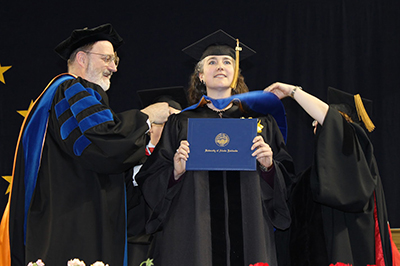 Even after retiring and becoming a professor emeritus in 2015, Juday has continued to publish his work and is beginning to bring his research data sets into modern digital formats.
Even after retiring and becoming a professor emeritus in 2015, Juday has continued to publish his work and is beginning to bring his research data sets into modern digital formats.
"I have been faithful in keeping the data all of these years, but with the climate change issue exploding all around me and the demands on my time, I was running as hard as I could doing media appearances, plus classes, research, finding funding, etc.," Juday said. "I can finally do the research again. When I feel like it, I can pick a nice day, go out in the field and take the measurements for the year. That is really nice."
In 2022, Juday adds the Purdue FNR's Lifetime Achievement Award to his list of career accolades, following the 2021 George B. Fell Award from the Natural Areas Association, which he received for his accomplishments in the natural areas profession.
"I was so shocked when I found out I had been selected for this Lifetime Achievement Award," Juday said. "This one and the George Fell Award mean more to me than anything. They are from my roots, from the institutions that I have worked in and with and they are given by my people, a diverse people that are drawn by a common interest that motivates them and gives their life direction.
"With the FNR Award in particular, I grew up next to this institution, I went there and then went out into the larger society and exercised the capabilities that I developed there. To have the institution give me this award in the end is just like one of those corny Hollywood movie endings."
So what are the takeaways from a storied career that doesn't fit one particular field or area of emphasis?
"My parents taught me not to brag, but there are natural areas that exist and are thriving today in Indiana, Oregon and Alaska that may not have been had I not been one ingredient in the picture," Juday said. "Our approach in natural resource management is different now than it used to be, it is more holistic and broader, and there were a lot of people who contributed to that change in mentality and I was just one of them. Whether in old growth forests, the emergence of biodiversity and conservation biology in policy, the implementation of recovery actions from the Exxon Valdez oil spill or in climate change, so many people play a role.
"There comes a branching point in a career, where somebody did something generous and supportive or nurtured you, and allowed your life and contributions to continue. There are so many people that I have benefited from in that way. It was essential to what happened in my life and what I was able to do. I just hope to encourage people to look for the opportunity they might be able to play, to be supportive and bring out the best in people. We will all be better off because of that."


